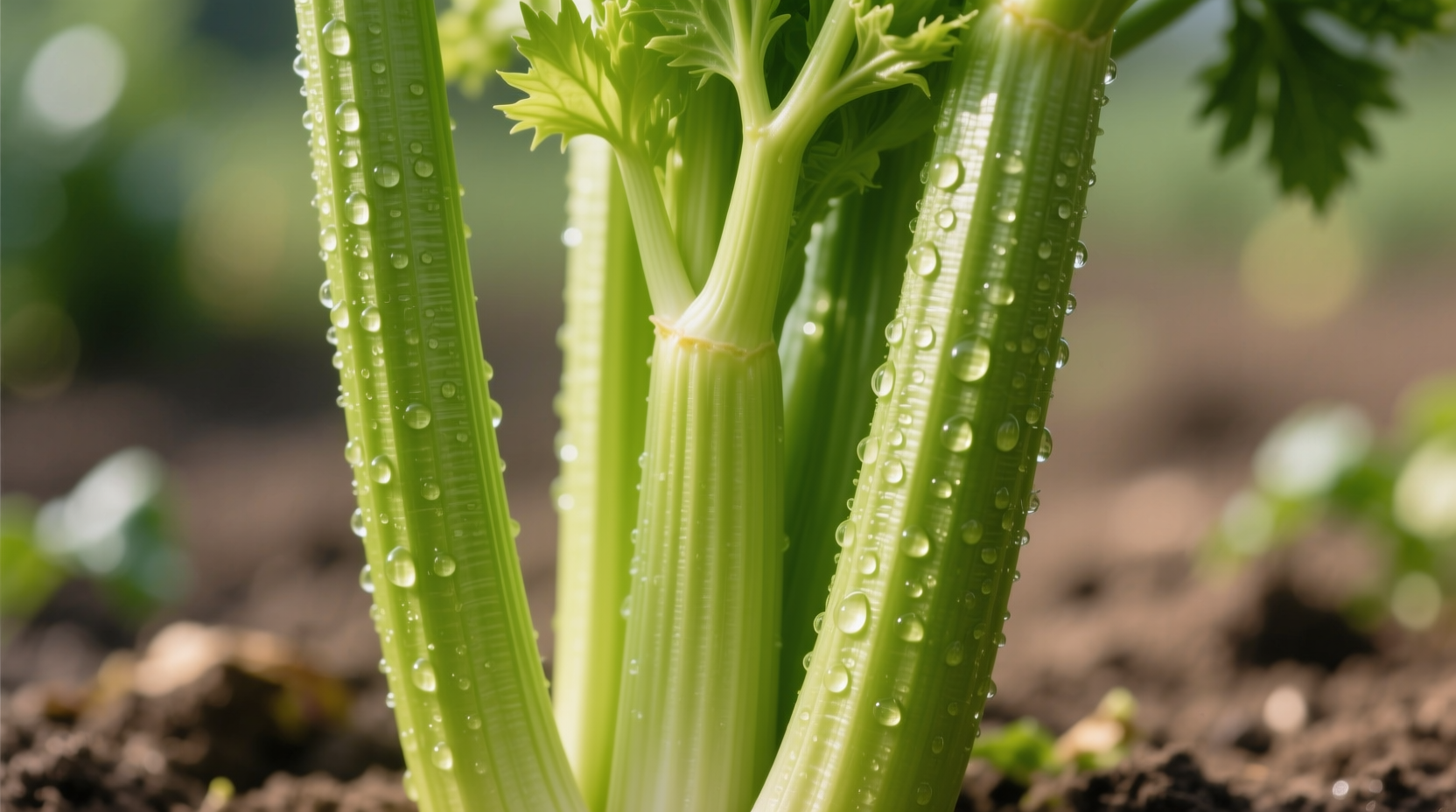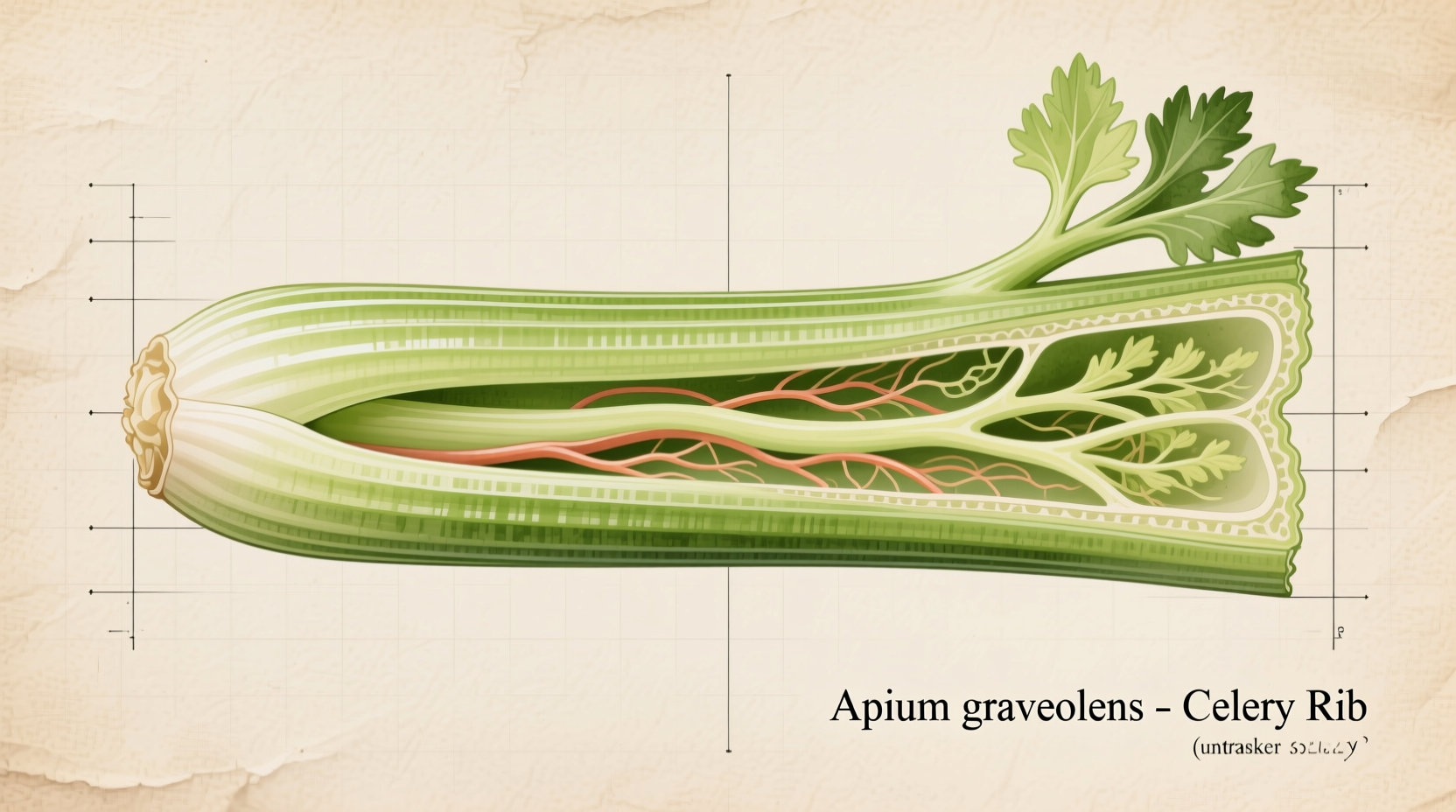A celery rib is simply another term for a celery stalk—the long, curved, crunchy segments that make up a head of celery. Despite common confusion, “rib” and “stalk” refer to the exact same part of the plant, with “rib” being the preferred culinary term in professional kitchens.
Ever stood in the grocery store wondering whether to grab “celery ribs” or “celery stalks” for your recipe? You're not alone. This terminology confusion trips up home cooks and professionals alike. Let's clear up the mystery once and for all and explore how to maximize this versatile vegetable's potential in your kitchen.
Understanding Celery Anatomy: Rib vs. Stalk Explained
The celery plant consists of multiple curved, parallel segments growing from a central base called the corm. Each individual segment—whether called a rib or stalk—features the same structural components:
- Outer curved surface: The smooth, waxy exterior that provides crunch
- Inner concave side: The slightly textured interior where leaves once attached
- Fibrous strands: Vertical strings running the length that affect texture
- Leaf end: Where delicate fronds once grew (often trimmed at market)
| Terminology Comparison | Culinary Context | Botanical Accuracy |
|---|---|---|
| Celery Rib | Preferred in professional kitchens; refers to individual segments | Technically incorrect (true ribs are leaf veins) |
| Celery Stalk | Common grocery label; sometimes refers to entire bunch | More botanically accurate term |
| Celery Stick | Refers to cut pieces for snacking or garnish | Not a botanical term |
This terminology discrepancy stems from historical usage. Professional chefs adopted “rib” early in the 20th century, likely influenced by butchers' terminology for meat cuts. Despite being botanically inaccurate, the term stuck in culinary circles. The USDA's FoodData Central database uses “stalk” as the standard reference, confirming the interchangeable nature of these terms in practical usage.
Why Celery Ribs Deliver Unique Culinary Value
Celery ribs offer distinctive properties that make them indispensable in cooking:
The Flavor Profile Advantage
Unlike many vegetables, celery ribs contain volatile compounds that release flavor at different cooking stages:
- Raw: Bright, grassy notes with subtle saltiness (perfect for crudité)
- Sauteed 1-3 minutes: Sweet vegetal flavor emerges
- Mirepoix stage (5+ minutes): Deep umami base for sauces and stocks

Nutritional Powerhouse in Disguise
While often dismissed as “just crunch,” celery ribs deliver surprising nutritional benefits according to USDA data:
- One medium rib (40g) contains just 6 calories but provides 14% of daily vitamin K needs
- Rich in apigenin, a flavonoid with potential anti-inflammatory properties
- Natural sodium content (80mg per rib) makes it valuable for low-salt cooking
- Contains lutein and zeaxanthin for eye health
Mastering Celery Rib Preparation Techniques
Professional chefs employ specific methods to maximize celery rib performance:
The String Removal Debate
Those fibrous strands running vertically through ribs can create unpleasant texture. Here's when to remove them:
- Always remove: When using raw in salads or smoothies
- Optional removal: For mirepoix or long-cooked dishes (strands soften)
- Best technique: Use a vegetable peeler to lift end fibers, then pull downward
Storage Secrets for Maximum Freshness
Proper storage dramatically extends celery rib shelf life:
- Wrap ribs tightly in aluminum foil (not plastic)
- Store vertically in refrigerator crisper drawer
- Change foil every 7 days to prevent moisture buildup
- Revive limp ribs by soaking in ice water for 30 minutes
This method maintains crispness for 3-4 weeks—nearly double standard storage. The foil allows ethylene gas to escape while retaining moisture, preventing both dehydration and spoilage.
Culinary Applications: When to Use Whole Ribs vs. Diced
Understanding context boundaries prevents common cooking mistakes:
- Whole ribs excel in: Broths, poaching liquids, and as vegetable handles for delicate items
- Diced ribs work best: Mirepoix, stuffings, and quick-cooking dishes
- Sliced ribs shine: Stir-fries and slaws where controlled texture matters
- Avoid overcooking: Beyond 8 minutes in simmering liquids turns ribs mushy
Chef Thomas Keller's Ad Hoc at Home demonstrates this principle perfectly: whole ribs simmered for stock, then discarded after flavor extraction, while diced ribs remain in finished dishes like soups for texture.
Historical Evolution of Celery Rib Usage
Celery's culinary journey reveals why ribs became kitchen staples:
- 16th century: Wild celery used medicinally in Europe (too bitter for cooking)
- 1800s: Dutch breeders develop Pascal celery—the ancestor of modern ribs
- 1920s: Refrigerated transport makes celery widely available year-round
- 1950s: “Ants on a log” popularizes celery ribs as edible vessels
- Today: Food scientists study celery rib fibers for sustainable packaging alternatives
This evolution explains why professional kitchens standardized “rib” terminology—during celery's rise as a culinary staple in the early 20th century, chefs needed precise language for this newly important ingredient.
Putting Celery Ribs to Work: Practical Applications
Transform your cooking with these professional techniques:
The Flavor-Boosting Trivet
Place whole celery ribs in roasting pans beneath meats. They:
- Elevate proteins for even cooking
- Prevent sticking without added fat
- Infuse subtle flavor into drippings
The Secret Stock Enhancer
Save trimmed rib ends and leafy portions in freezer bags. When making stock:
- Add frozen ends directly to pot
- Simmer 45 minutes for maximum flavor extraction
- Strain before using for crystal-clear results
The Texture Control Method
For perfect celery rib texture in salads:
- Cut ribs on sharp diagonal (increases surface area)
- Soak in ice water with lemon juice (1 tbsp per cup) for 20 minutes
- Pat completely dry before dressing
This technique maintains crispness while preventing sogginess—a trick used in Michelin-starred restaurants worldwide.
Frequently Asked Questions
Are celery ribs and celery stalks the same thing?
Yes, celery ribs and celery stalks refer to the exact same part of the plant. “Rib” is the preferred culinary term used in professional kitchens, while “stalk” appears more commonly on grocery labels. Both terms describe the individual curved segments that grow from the celery plant's base.
How many celery ribs equal one cup chopped?
Three medium celery ribs yield approximately one cup of chopped celery. This measurement holds true whether diced small for mirepoix or cut into larger pieces for stir-fries. The USDA's FoodData Central confirms this standard conversion used in recipe development.
Why do some celery ribs have more strings than others?
String quantity depends on growing conditions and harvest timing. Ribs grown in cooler temperatures develop thicker fibers as a protective mechanism. Older plants also produce more fibrous ribs. The outer ribs of a bunch typically contain more strings than inner ribs, which grow in a more protected environment.
Can you eat celery ribs raw?
Yes, celery ribs are commonly eaten raw in salads, crudité platters, and as edible vessels for dips. Raw celery provides the maximum crunch and bright flavor. For best texture when eating raw, remove the fibrous strings using a vegetable peeler and soak in ice water for 15-20 minutes to enhance crispness.











 浙公网安备
33010002000092号
浙公网安备
33010002000092号 浙B2-20120091-4
浙B2-20120091-4